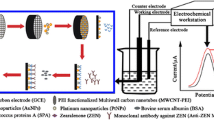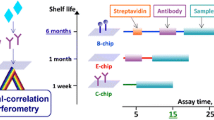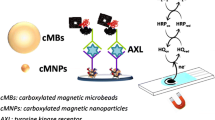Summary
Antibodies immobilized on the surface of titanium wires may be used as direct potentiometric immunoelectrodes. In order to make full use of the potentially high selectivity and sensitivity of such sensors, careful investigations on the optimization of immobilizing proteins on such surfaces have been carried out. The final process uses a polystyrene coating on titanium wires with subsequent immobilization of proteins by azo coupling. The best suited buffer solution for IgG coating was found to be carbonate buffer pH 9.18 and a second coating with BSA could be shown to close yet active sites of titanium or polystyrene, thus preventing unspecific binding of any small molecules/antigens. This latter finding will be especially important with immunoelectrodes, where such small molecules would replace buffer ions at those sites, which would most probably yield high potential changes covering completely the desired measuring effects from the binding of a small antigen to an immobilized antibody.
Similar content being viewed by others
References
Yamamoto N, Nagasawa Y, Sawai M, Sudo T, Tsubomura H (1978) J Immunol Methods 22:308
Yamamoto N, Nagasawa Y, Shuto S, Tsubomura H, Sawai M, Okumura H (1980) Clin Chem 26:1569
Yamamoto N, Nakaoka S, Tanaka T, Shiro T, Honma K, Tsubomura H (1983) Proceedings on the International Meeting on Chemical Sensors, Fukuoka 1983, Elsevier, Amsterdam, p 699
Janata J (1975) J Am Chem Soc 97:2914
Taniguchi I, Fujiyasu T, Tomimura S, Eguchi H, Yasukouchi K, Tsuji I, Unoki M (1986) Anal Sci 2:587
Yamamoto N, Shuto S, Tsubomura H (1981) Appl Biochem Biotech 6:319
Nakabayashi I, Tomida T, Kawashiro K, Morimoto S, Abe S (1985) Hyomenkagaku 6:206
Tsuruta H, Tsubomura H (1988) Appl Biochem Biotech 19:151
Nakabayashi I, Tomida T, Kawashiro K (1985) J Electrochem Soc 132:2611
Thompson M, Tauskela JS, Krull UJ (1987) In: Ngo TT (ed) Electrochemical sensors in immunological analysis, Plenum Press, New York, p 1
Redepenning JG (1987) Trends Anal Chem 6:18
Hornby WE, Filippusson H, McDonald A (1970) FEBS Lett 9:8
Tijssen P (1987) Practice and theory of enzyme immunoassay, Elsevier, Amsterdam
Gallati H, Brodbeck H (1982) J Clin Chem Biochem 20:221
Schwalbe M (1983) Thesis, Univ of Mainz
Schmid RD (1987) Nachr Chem Tech Lab 35:910
Chang TMS (1975) In: Weetall HH (ed) Immobilized enzymes, antigens, antibodies and peptides, Marcel Dekker, New York, p 245
Author information
Authors and Affiliations
Rights and permissions
About this article
Cite this article
Pfeifer, U., Baumann, W. Direct potentiometric immunoelectrodes. Fresenius J Anal Chem 343, 541–549 (1992). https://doi.org/10.1007/BF00322165
Received:
Revised:
Issue Date:
DOI: https://doi.org/10.1007/BF00322165




